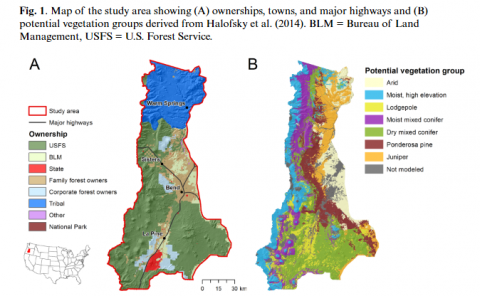Long-term restoration synergies between wildfire and forest management on fire frequent landscapes.
Our objective was to examine whether accelerated management can maintain or promote desired ecological conditions under potential future fire regimes that are amplified by either climate, fire management policies, or a combination of the two. We used the agent-based forest landscape succession and disturbance model Envision in a series of experiments to simulate future fire scenarios consistent with predictions of recent climate change studies, along with multiple intensities of management. The study area was a fire frequent landscape encompassing two national forests in central Oregon. We incorporated agent behavior with respect to specific land management practices for federal and private industrial forests. Landscape response was measured in terms of forest resiliency, patch size of high-severity fire, aboveground carbon, potential future high severity fire, and fire-on-fire feedbacks.
- We found that wildfire was more effective at reducing future high-severity fire, while mechanical forest management was more effective in restoring pre-settlement patches of fire resilient, mature forest.
- High-severity fire patch size decreased with increasing fire.
- Both disturbances reduced aboveground carbon over time, although the magnitude varied substantially among the fire-management combinations.
- Federal forest management practices were more effective at reducing high-severity fire and increasing resilient forest structure compared to those on private industrial forests.
- We observed synergistic effects where specific combinations of fire and management accelerated landscape change towards resilient conditions, compared with stand-alone disturbances.
- We also observed both negative and positive fire feedbacks - fires that reburned areas within 5 to 10 years had reduced spread rates within prior fire footprints, whereas the longer-term effect of accelerated fire was to create a landscape dominated by early successional vegetation with higher spread rates.
- The results suggested that forest management can both accelerate or slow the rate at which wildfire can be used as a treatment to achieve restoration objectives, but variability among scenario replicates points to high levels of uncertainty associated with policies that rely on natural fire.
- This study contributes to understanding how wildfire and forest management can be combined to strategically restore fire resiliency on multi-owner landscapes.
